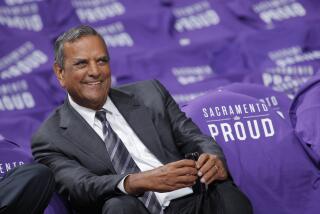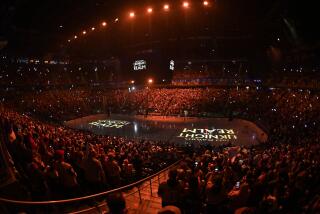North Stars Are Skating on Thin Ice in Minnesota
- Share via
BLOOMINGTON, Minn. — This is the land of 10,000 lakes and one failed National Hockey League team that is a monument to mismanagement and miscalculation.
Hockey will outlast the North Stars in Minnesota because lacing on skates and whacking a puck across those 10,000 frozen ponds are traditions passed on from generation to generation.
The tradition is not only alive, but healthier than ever: The annual state high school tournament, just completed, attracted sellout crowds for its preliminary-round games and to the finals at the St. Paul Civic Center. Round-the-clock telecasts showed roaring crowds, vibrant enthusiasm, lively games.
The University of Minnesota Golden Gophers draw the same response, averaging more than 7,000 fans a game, and the Western Collegiate Hockey Assn. playoffs averaged 11,962 fans a game at the Civic Center.
It’s the same game but a different scene in suburban Bloomington. There, the North Stars skate before a crowd that might, if it’s a Saturday and if there’s a giveaway and if the roads are free of ice, fill 10,000 of the Met Center’s 15,093 seats. Starting with a base of 3,800 season tickets, one of the smallest bases in the NHL, the North Stars this season have been averaging only 11,274 fans a game.
That’s more than 3,000 below the NHL average but it’s an increase over last season’s average of 9,795.
“Minnesota isn’t the wrong place for hockey,” said Jack Ferreira, the North Stars’ general manager. “It’s just wrong for the Minnesota North Stars.”
How could a professional hockey team go wrong in a state that is home to 45,000 registered amateur hockey players and the U.S. Hockey Hall of Fame? How could the North Stars miss in a state that has sent a steady stream of players to the NHL and this season has 19 in the league?
It wasn’t easy, but they’ve managed to extract nothing but fool’s gold from a gold mine.
The team has been on a financial and aesthetic decline since 1981, when it made its only appearance in the Stanley Cup finals and lost to the New York Islanders. The North Stars averaged 15,784 fans a game that season and topped 15,000 a game each of the next three seasons, but fans soured after getting too many failed promises and postseason failures.
The team lost $6.5 million last season and $16 million over the past four years, despite paying a paltry annual rent of $175,000 and keeping parking and concession revenues. Its television revenues for 40 games this season will be less than the $1.58 million a local TV station paid the Minnesota State High School League to televise portions of the state hockey tournament.
“We were going 85, 86 (points) and every year we dropped season tickets,” said Lou Nanne, the team’s general manager from 1977 to 1988 and now its president. “We sold winning the Stanley Cup rather than professional hockey as entertainment. Maybe we encouraged them to expect too much after we went to the finals in ’81.”
Team owners George and Gordon Gund forced the issue in late January when they announced they would sell the team or move it to the San Francisco Bay Area unless the Metropolitan Sports Facilities Commission--which owns Met Center--agreed to make $15 million in improvements to the building. George Gund, who lives in the Bay Area, and his brother, Gordon, who is head of a financial investment corporation in Princeton, N.J., assumed controlling interest in the team in 1978 after their Cleveland Barons--nee California (Oakland) Seals--merged with the North Stars. Their net worth is estimated at $1.1 billion by Forbes magazine.
The price they set for the franchise was $50 million. Not surprisingly, they’ve gotten few offers.
One was from Minneapolis businessman and author Harvey Mackay, who has a supporting cast that includes, among others, Carl Pohlad, owner of the Twins; Northwest Airline, the Pillsbury Company, insurance companies and a TV-radio station.
The other was from Compuware, a Michigan-based computer company. Compuware is considered the more serious of the two and has the financial resources, but an NHL insider said: “Once (Compuware officials) check over the books and see it isn’t going to work, they’re going to withdraw their offer.”
That would leave the Gunds with one option: moving to the Bay Area. Approval by the NHL’s Board of Governors would be required, and a meeting was held Monday in Chicago to discuss the situation, but the team’s relocation application won’t be formally considered until April. The governors showed their receptiveness to a move earlier this month when they passed an amendment to the league’s bylaws that would allow a team to move with a majority vote by the Board.
The Gunds referred questions about the team to Arthur Savage, who is Gordon Gund’s financial adviser. Savage wouldn’t say whether the brothers prefer to keep or sell the team, but he said they won’t stay in Minnesota simply because of sentiment within the NHL that a team can and should succeed there. “If there’s someone out there who would like to buy the team and keep the North Stars there, let them have a try at it,” Savage said. “If there isn’t, we don’t feel we should be forced to stay there and be forced to lose $5 to $6 million a year.”
Although Oakland spurned Charles O. Finley’s Seals in the 1970s, the Gunds believe hockey will succeed this time around.
“That was 15 years ago. The Oakland A’s were drawing 700,000 and the (San Francisco) Giants weren’t drawing, and this year they both combined to draw 5 million,” Savage said. “The Warriors (of the NBA) sell out every game and they’re not even a playoff team. There’s a big interest in sports. Our research indicates the Bay Area will support a team.” Savage said the area’s avid interest in amateur hockey has hurt the North Stars.
“There’s so much other hockey that’s available, from junior to high school to college, and there’s only so much room and so much time to devote to professional hockey,” he said. “This is more hockey country for the amateur level than the professional level. Unfortunately, we have to make payrolls. This is a business. They don’t have to make payrolls in high school and college. . . . There’s too many choices, if you will. College hockey is equally interesting to people there and it’s much less expensive.”
One of the North Stars’ most costly mistakes was not hiring Herb Brooks as coach in the early 1980s. Brooks, who was born in St. Paul, coached the University of Minnesota to three NCAA championships and became an unassailable hero when he coached the 1980 U.S. Olympic hockey team to the gold medal at Lake Placid, N.Y. He coached in Switzerland and then in New York before joining the North Stars’ bench in the fall of 1987. Brooks was not retained when Ferreira succeeded Nanne.
“Letting Herbie go was a PR disaster,” Nanne said, “but the owners said the new manager should be able to pick his coach.”
As absentee owners, the Gunds could not grasp the extent of Brooks’ popularity. Brooks would not comment about his stint with the North Stars, and about the team’s plight, saying only that he doesn’t buy the theory that the team is the victim of a hockey glut.
“Amateur and professional hockey can coexist in a real positive way,” said Brooks, a commentator for NHL telecasts on SportsChannel America. Nonetheless, the North Stars’ departure seems inevitable. The vacuum it creates probably would be filled in the next wave of expansion, leaving another owner to learn from the Gunds’ mistakes.
Or repeat them.
BACKGROUND
The Minnesota North Stars were one of six teams added to the NHL before the 1967-68 season--the Kings, California (Oakland) Seals, Pittsburgh Penguins, Philadelphia Flyers and St. Louis Blues were the others. The Seals moved to Cleveland and became the Barons for the 1976-77 season, then merged with the North Stars for the 1978-79 season. Since then, the team has played its home games in Bloomington, Minn. If a Minnesota buyer cannot be found, the team probably will move to the San Francisco Bay Area.
WHERE HAVE ALL THE FANS GONE?
The Minnesota North Stars set a team attendance record in 1980-81, when they reached the Stanley Cup finals. Since then, average attendance at North Star games in Met Center has dropped considerably. In the same period, average attendance at all NHL games has risen to record levels annually.
Season Record, Playoff Results Minn. Avg. NHL Avg. 1980-81 35-28-17, reached Stanley Cup finals 15,784 12,877 1981-82 37-23-20, lost in first round 15,621 12,920 1982-83 40-24-16, lost in second round 15,404 13,277 1983-84 39-31-10, lost in third round 15,210 13,700 1984-85 25-43-12, lost in second round 14,471 14,001 1985-86 38-33-9, lost in first round 14,127 14,006 1986-87 30-40-10, failed to reach playoffs 13,512 14,282 1987-88 19-48-13, failed to reach playoffs 11,440 14,577 1988-89 27-37-16, lost in first round 9,643 14,908 1989-90 30-37-4, battling Detroit for playoff spot 11,274 15,000*
* Estimate. NHL does not release attendance figures until after playoffs.
Sources: Minnesota North Stars and NHL.
More to Read
Go beyond the scoreboard
Get the latest on L.A.'s teams in the daily Sports Report newsletter.
You may occasionally receive promotional content from the Los Angeles Times.







